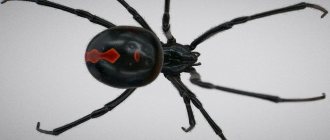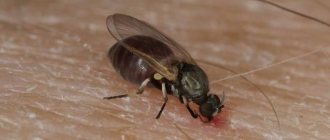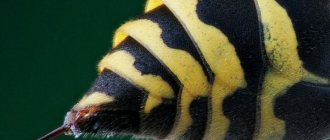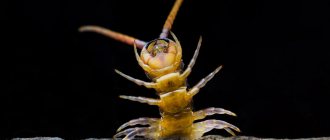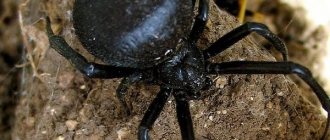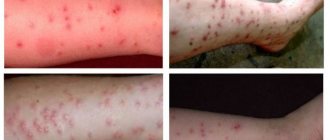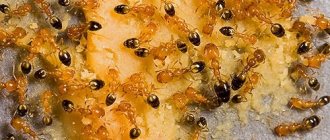A centipede encountered in one's own apartment often terrifies people. An insect running quickly seems dangerous and aggressive. In fact, such statements have a basis. The centipede insect is a predator; it is indeed capable of attacking and biting, but not a person, but a fly or moth. She tries to avoid contact with people, hiding in hard-to-reach corners. If there is a clear threat, the centipede may bite; the insect's venom causes problems for people with allergies.
What does a flycatcher look like and where does it live?
The adult insect has an elongated, flattened body consisting of 15 segments. For each segment there is one pair of legs, the length of which increases from the head to the tail. The last pair of legs are so elongated that they look more like antennae (can be confused with the head). Due to the large number of long thin legs, scutigera looks like a hairy or shaggy centipede.
The first pair of legs are transformed into jaws, with which the centipede grabs prey and defends itself from enemies. When hunting, flycatchers inject poison into the body of the victim and then eat it. Flycatchers have good eyesight and a movement speed of up to 40 cm/sec. The antennae are whip-like, very long. The color is yellowish-gray or brownish, with three stripes along the body.
The flycatcher lives 3-7 years, growing up to 6 cm. You can distinguish an adult insect from a young one by the number of legs. The centipede that emerges from the egg has only 4 pairs of them. The number of legs increases after each molt, eventually reaching 15 pairs.
The range of flycatchers covers the distance from Southern Europe to North Africa. On the territory of Russia, it lives in the Black Earth Region, the Caucasus, Crimea and the Volga region.
What insects are called centipedes?
Millipedes belong to the superclass of invertebrate animals, of which there are currently more than 12,000 species in the world.
They are all united by external similarities: a 4- or 5-segmented head, behind which is a body, also consisting of segments. But the number of legs can be different: the minimum number is up to 10, the maximum is over 700.
Interesting!
There is currently a debate among scientists whether centipedes are relatives of insects (that is, a sister group) or whether they can be related to chelicerates (mites, spiders, crustaceans).
In temperate climate zones, centipedes with body sizes ranging from 3 cm to slightly more than 5 cm live. They have a head with compound eyes, antennae with numerous segments and a chitinous skeleton. It is with the help of the antennae that the creature can navigate in space, look for suitable safe places, and indicate temperature fluctuations.
They move quickly, covering 40 cm per second.
The shades of the body can be both light and dark. Longitudinal purple or blue stripes are visible on the back.
Interesting!
Excavations have confirmed the existence of millipedes about 400 million years ago in the Silurian period, which superficially resemble modern arthropod species.
What attracts flycatchers to a person’s home?
In nature, flycatchers live in fallen leaves; in the winter they crawl into places sheltered from the cold. They penetrate into human habitation mainly in the fall, due to the beginning of their passages. Room temperature is quite comfortable for these predators. In the house they choose dark places: spaces under the bathroom, basements, and continue to lead a predatory lifestyle - they catch all the insects they can find.
Habitat and food
Millipedes inhabit a variety of habitats, but are most common in forests. They are also found in deserts, savannas and grasslands. Most millipedes are detritivores (animals that feed on decaying organic matter). The exception is labiopods, which are nocturnal predators and feed on a variety of animals, including amphibians, reptiles, mammals, birds and various invertebrates. Two other lesser-known classes of millipedes, pauropods and symphylans, are small organisms (some species are microscopic) that live in the soil.
Are flycatchers harmful?
The flycatcher is a useful creature that exterminates many insect pests. She is a real helper in the garden and vegetable garden. Therefore, if a flycatcher is found in the house during the warm season, it is better to carefully catch it with a jar or box (not with your hands!) and take it outside.
In the apartment, she does not damage the furniture and does not touch human food. She is only interested in insects, and in a few weeks she can clean an apartment of them no worse than a vacuum cleaner.
The flycatcher does not tolerate any diseases, does not attack humans or animals, and generally tries to stay away from all household members. Despite the fact that the insect is poisonous, its disposition is peaceful. If possible, she will not enter into conflict - she will simply run away. Of course, she can try to bite, but only in self-defense.
In southern countries, centipedes are welcome guests in gardens and fields; here they are protected and their contribution to the fight against agricultural pests is appreciated.
What happens if a flycatcher bites?
Most often, the flycatcher fails to bite through the skin, unless we are talking about delicate children's or very thin women's skin. If she does manage to pierce the skin and inject poison, the bite will feel similar to a bee sting, and the symptoms will also be redness, burning, itching. The flytrap venom is not dangerous for people; it can only cause harm if there is an individual intolerance or an allergic reaction.
The flycatcher may try to bite domestic animals, defending itself from them. As in the case of a person, she will hardly be able to bite through their skin. But even if this happens, its bite and poison will not entail negative changes in the condition of the pets.
Much more dangerous than flycatchers are centipedes, another type of centipede with which, out of ignorance, they are sometimes confused. Although the scolopendra bite is not fatal to humans (with the exception of tropical species of scolopendra), it is very painful and can cause severe swelling that does not subside for several days. Scolopendra venom is especially dangerous for small children and can kill a cat or other small animal.
Types of centipedes
Lipopods, biparopods, symphylos and pauropods, tracheal-breathers - these are 4 classes united under the general name “centipedes”. These creatures are found all over the globe, but depending on the climate, they differ in size, color and degree of danger.
Let's look at the most common types of centipedes.
Scolopendra californica
Body length is about 20cm. Not only its bite is dangerous, but also contact with it.
Giant scolopendra
Habitat: South America, Jamaica, Trinidad. The poison is fatal to humans.
drupe
Her body is not very large, and there are not many legs either. Habitat: forests of European Russia.
Common flycatcher
Arthropods are active at any time of the day. Can reach a length of 3-6 cm. Eats other arthropod pests. Winters in human dwellings.
Kivsyaki
Habitat: temperate latitudes, prefer forest litter. Not dangerous for people.
What to do if bitten by a centipede (flycatcher, centipede)
When bitten you need:
- Wash the wound with soap and water.
- Disinfect with any suitable means: for example, alcohol, vodka, cologne, boric acid or calendula tincture.
- Apply a cold compress for 40 minutes if the burning sensation is severe and swelling has formed.
- Take a pain reliever or antihistamine if necessary.
Next, you need to observe changes in your well-being. If alarming symptoms appear (severe malaise, nausea, confusion, vomiting), you should consult a doctor. As a rule, nothing like this happens.
In the case of scolopendra, everything is much more serious - the result can be severe swelling (if a limb is bitten, it will swell entirely), an increase in temperature and a sharp deterioration in well-being.
If you are bitten by a scolopendra, instead of a cold compress, you can apply a heating pad with a temperature of 45 °C. Under the influence of this temperature, the scolopendra venom is partially destroyed, and the person feels better. But still, in this case, it is better to immediately seek medical help, and if a child or small pet is bitten, it is imperative to seek help from a doctor.
Where do centipedes live?
The common centipede has adapted to life in such regions of our planet as North Africa, the Middle East, the Mediterranean countries, and the southern part of Europe. In the Russian Volga region you can also find a multi-legged creature.
Arthropods usually prefer shelters under stones, plant roots, and leaf litter. She is attracted to wet and damp places. It is there that she feels protected, where the processes of reproduction and basic life activities take place.
The centipede goes hunting both during the day and at night.
A person can most often see an animal in his home in the autumn, when the cold sets in. The flycatcher is looking for a place where it can hibernate until spring. To do this, she chooses places where there is moisture, dampness and little light. Bathrooms, toilet rooms, and basements are suitable for them.
Why are people afraid of flycatchers?
The fear of centipedes and the hostility towards them on the part of people is explained mainly by two facts: disgust for their appearance and fear that they might get into the ear. The last statement is more related to the common myth about earwigs, which, according to some people, are able to get into the ear of a sleeping person, bite through the eardrum and penetrate the brain. Flycatchers are confused with earwigs, so they are just as feared.
In fact, neither the flycatcher nor the earwig has any intention of getting into human ears, much less capable of gnawing on the eardrum and brain. Besides, they don’t need it at all; they don’t feed on the brain.
It happens that small insects get into people's ears (most often these are flies, midges or cockroaches). Under no circumstances will a flycatcher climb into the ear canal - there is nothing attractive there for it and with its long legs it is completely inconvenient.
Flycatchers in the house - how to get rid of them
There are not many flycatchers in a living room, because this is an unusual habitat for them, and they are unlikely to breed in an apartment. Therefore, flycatchers can be easily caught and sent outside.
If you decide to get rid of flycatchers in your apartment using radical methods, that is, destruction, you need to take into account the peculiarities of their nutrition, body structure and behavior. For example, if sticky traps are removed, they are ineffective in combating insects - the insect tears off the stuck legs and runs away. Baits for cockroaches and ants also have no effect on them, because flycatchers are predators; they feed on live insects.
You can kill a flytrap with any hard object, boiling water or insecticide (it’s more convenient to use sprays). Any insecticide will do; flycatchers are not resistant to them.
You can make the flycatchers leave the apartment on their own. For example, if you get rid of all the insects in the apartment, they will have nothing to eat and will have to go in search of a more suitable place.
They love humidity, so you can often encounter them in the bathroom. If you do not allow moisture to accumulate in the bathroom and ventilate it regularly, the flycatchers will soon become uncomfortable here and will leave.
You can block access to the house for flycatchers, as well as various insects, by caulking all the cracks in the walls, floor and basement, as well as installing mesh on the ventilation outlets.
Social structure and reproduction
Photo: Centipede at home
All centipedes are loners, but in case of a chance meeting, individuals usually quietly crawl away and fights between them are extremely rare. There were no cases of cannibalism among these creatures. The last days of May or the beginning of June is the breeding season of centipedes. By this time, females begin to produce special substances, attracting a male.
Their fertilization process is peculiar:
- the male closes the entrance to his dwelling in the ground with a web and deposits his spermaphore in the resulting sac;
- the female crawls under the sperm sac and grabs it with her genital appendages, and after a few days lays eggs in a dug hole, which she then covers with sticky mucus.
The clutch may consist of 70-130 eggs. For several weeks, the female guards the clutch, clasping it with her paws. To protect against mold, it secretes a special substance. The larvae emerge together. They are initially white in color and very soft with four pairs of legs. With each molt, the young grow new pairs of legs, and the body color gradually darkens. Only after the fifth or sixth molt the larvae will have 15 pairs of limbs. Under natural conditions, centipedes live 4-6 years. Young animals become completely similar to adults only after puberty.



